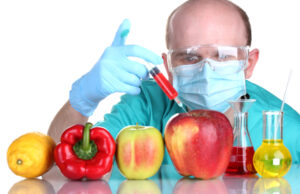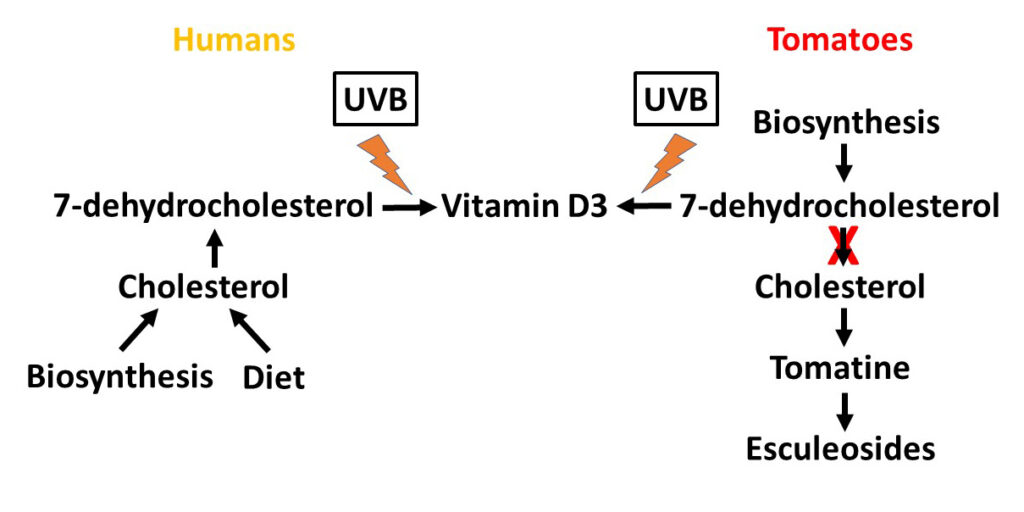The Good And Bad Of Genetically Modified Foods
Author: Dr. Stephen Chaney
 The Floodgates have been opened. The USDA has just approved a genetically engineered purple tomato that contains the anthocyanins found in blueberries, blackberries, and eggplant. It could be appearing in your supermarkets as early as next spring.
The Floodgates have been opened. The USDA has just approved a genetically engineered purple tomato that contains the anthocyanins found in blueberries, blackberries, and eggplant. It could be appearing in your supermarkets as early as next spring.
And that is just the beginning. Several other genetically modified tomatoes are waiting in the wings. One example is a tomato that has been genetically engineered to produce vitamin D3 (J Li et al, Nature Plants, 8: 611-616, 2022).
“Why would you want that?”, you might ask. The rationale is simple:
- It starts with the fact that one billion people worldwide (J Li et al, Nature Plants, 8: 611-616, 2022) and 42% of the US population have vitamin D insufficiency (KYZ Forrest and WL Stuhldreher, Nutrition Research 31: 48-54, 2011), which is defined by the NIH as vitamin D levels that are “inadequate for bone and overall health in otherwise healthy individuals”.
- And vitamin D insufficiency is not a trivial matter. In the words of the authors, in addition to bone health, vitamin D insufficiency “impacts immune function and inflammation and is associated with increased risk of…cancer, Parkinson’s disease, depression, neurocognitive decline, dementia, and the risk of coronavirus disease…”
- Add to that the fact that tomatoes are grown and consumed in more than 170 countries worldwide. The authors felt that increasing the vitamin D content of tomatoes could be a simple and effective way to improve the vitamin D status of millions of people around the world.
In their own words, “We have developed a new dietary source of vitamin D in plants to meet the increasing demand for ways to address vitamin D insufficiency, which is of particular relevance to those adopting plant-rich, vegetarian or vegan diets.”
But is that true and is it safe? That is the topic of today’s health tip. But before I cover those topics, I should give you some background on vitamin D metabolism in humans and in plants.
Metabolism 101: Vitamin D Metabolism In Humans & Plants
7-dehydrocholesterol is the precursor to vitamin D3 in both humans and plants, but the amount of 7-dehydrocholesterol and the metabolic pathways producing it are very different.
- In humans, cholesterol is the precursor to 7-dehydrocholesterol. About 70% of cholesterol is synthesized by the liver, with the remaining 30% coming from our diet.
- 7-dehydrocholesterol is synthesized from cholesterol in the epidermis (outer layer) of our skin. It is present in large amounts there but is present in only small amounts in the rest of the body.
- UVB light is a component of sunlight, and UVB light drives the conversion of 7-dehydrocholesterol into vitamin D3 in our skin.
Plant Vitamin D3 Metabolism:
- In plants, the pathway is reversed. 7-dehydrocholesterol is synthesized from other plant sterols. And 7-dehydrocholesterol is converted to cholesterol.
- Cholesterol, in turn, is used to synthesize glycoalkaloid compounds that protect the plants from pests.
-
- The gylcoalkaloids differ from plant to plant. In tomatoes the major ones are α-tomatine and esculeoside A and B.
-
- α-tomatine and esculeoside A and B protect tomatoes from fungal, microbial, insect, and herbivoral attack.
- Normally, 7-dehydrocholesterol and cholesterol present in very low amounts in plants because they are used to synthesize protective glycoalkaloid compounds.
- UVB light is still required to convert 7-dehydrocholesterol to vitamin D3.
Can Tomatoes Be Engineered To Produce Vitamin D3?
Using modern genetic engineering techniques, the authors knocked out (deleted) the gene coding for the protein responsible for converting 7-dehydrocholesterol to cholesterol in tomatoes (shown as the red X in the figure above).
- 7-dehydrocholesterol levels are undetectable in ripe fruit of the wild-type tomato but were substantial in fruit of mutant tomatoes lacking the gene for converting 7-dehydrocholesterol to cholesterol.
- As expected, levels of α-tomatine and esculeoside A and B were substantially lower in the fruit of mutant plants.
- 7-dehydrocholesterol was evenly distributed in the skin and flesh of the fruit, which limited the ability of UVB light to convert all the 7-dehydrocholesterol to vitamin D3.
- Even so, a one-hour exposure of the fruit to UVB light produced about 2 μg of vitamin D3 in a medium sized tomato.
-
- That is equivalent to the vitamin D3 found in two eggs or 6 ounces of tuna, which are both recommended sources of vitamin D3.
-
- The only non-fortified foods that are better sources of vitamin D3 are salmon and trout, which provide about 15 μg of vitamin D3 in a 3-ounce serving
- The authors further speculated that the vitamin D3 content could be increased even more by:
-
- Cutting the fruit into slices and air drying them in sunlight.
-
- Removing the gene that produces UV-protecting chalcones in the skin of the fruit, thus allowing UVB light to penetrate further into the fruit. This is typical thinking by some of my scientific colleagues. If one mutation is good, two or more would be even better.
The authors concluded, “We have developed a new dietary source of vitamin D in plants to meet the increasing demand for ways to address vitamin D insufficiency”
In the leaves:
- Qualitatively, the results were similar to those seen with the fruit.
-
- 7-dehydrocholesterol levels were very low in the wild-type tomato but were substantially increased in the mutant tomatoes.
-
- Levels of α-tomatine and esculeoside A and B were substantially lower in the leaves of the mutant plants.
- Quantitatively, however, the results were different.
-
- The amounts of 7-dehydrocholesterol were 300 to 600-fold higher in the leaves than in the ripe fruit.
-
- The amount of vitamin D3 produced by a one-hour exposure to UVB light was 1,000-fold higher in the leaves than in the ripe fruit.
- While people don’t eat the leaves of tomato plants, the authors visualized a different use for this material.
-
- They envisioned using what would otherwise be waste vegetative material from growing tomatoes to produce vitamin D3 for vitamin D supplements.
-
- This would be particularly beneficial for vegans because most vegan sources of vitamin D are vitamin D2, which is less effective than vitamin D3.
In the words of the authors, “The leaves of the mutant plants are rich sources of 7-dehydrocholesterol…[and could be used] for the manufacture of vitamin D3 supplements from plants that would be suitable for vegans…”
The Good And Bad Of Genetically Modified Foods
 Like much else in today’s world of social media and online blogs and podcasts, both the benefits and risks of genetic engineering have been greatly exaggerated. I have discussed this topic at length in a previous issue of “Health Tips From The Professor”.
Like much else in today’s world of social media and online blogs and podcasts, both the benefits and risks of genetic engineering have been greatly exaggerated. I have discussed this topic at length in a previous issue of “Health Tips From The Professor”.
On the one hand, my genetic engineering colleagues tend to focus on the genetic alteration that is beneficial and ignore other changes in the genetically altered food that could pose some risk.
- I would be the first to admit that most of the risks are very small and unlikely to occur, but I think each potential risk should be thoroughly investigated before we release the genetically altered plant into the world.
- As an analogy, I will use the story of Pandora’s Box. Pandora was given the box by an angry Greek God, who told her never to open it. But her curiosity got the beat of her. Once Pandora opened the box, she released sickness, death, and other evils into the world. And once they had been released, there was no way to get them back into the box. We don’t want to run this kind of risk with genetically altered plants.
On the other hand, there are the “Chicken Little’s” of the world who assume every potential risk is real and warn us that, “The sky is falling”. Most of the risks are theoretical only. They may never happen. I am just saying they should be examined before we release genetically altered plants into the wild.
In this article, I will try to avoid both extremes. I will put on my “sceptic’s hat” (Every good scientist keeps one of those in his or her closet) and carefully evaluate the benefits and the risks associated with using both the fruit and the leaves of this genetically altered tomato plant.
Tomato Fruit Engineered To Produce Vitamin D3
The Benefit:
The benefit is obvious. As the authors said, tomatoes are a widely consumed worldwide. The availability of an inexpensive plant source of vitamin D3 could go a long way towards improving vitamin D status in third world countries where vitamin D3 supplementation may not be practical.
- Are there health risks?
- Most genetically engineered foods contain a protein sequence that is not found in the non-modified food. This raises the possibility of food allergies to the novel protein. The good news is that a protein has been removed in this mutant plant. There is no novel protein, so the chance of these tomatoes triggering food allergies is extremely small.
- However, these fruits do contain altered DNA. As I said in my previous article, one could imagine scenarios in which this could pose a health risk. I also pointed out that this is a theoretical concern, not one that has been proven to occur.
- In addition, these fruits have been irradiated with high-intensity UVB light for an hour. This converts some of the 7-dehydrocholesterol to vitamin D3. But what else does it do to the fruit? Are some of the changes harmful? The authors didn’t ask.
- Finally, these fruits don’t just have higher levels of vitamin D3. They also have much higher levels of 7-dehydrocholesterol than normal tomatoes. In humans, 7-dehydrocholesterol is made in the skin epidermis and there is very little in other tissues.
Is dietary 7-dehydrocholesterol a problem? We don’t know. One recent study speculated that dietary 7-dehydrocholesterol may increase the risk of atherosclerotic cardiovascular disease more than dietary cholesterol. Perhaps more study is required before we assume that this genetic modification is only beneficial.
2) Are there environmental risks?
- The same genetic change that increases the 7-dehydrocholesterol content of the fruit decreases α-tomatine and esculeoside A and B levels. As I stated above, α-tomatine and esculeoside A and B protect tomatoes from fungal, microbial, insect, and herbivoral attack (In my yard, herbivoral attack would be deer).
- The authors did not describe how these tomatoes were grown, but I would assume it was in a hothouse. That is customary for studies of newly genetically engineered foods.
- This raises the question of how pest susceptible these tomatoes would be when cultivated outdoors. Would increased amounts of pesticides and fungicides be needed to raise them? If so, what would the environmental impact be? The authors gave no indication that they had thought about the environmental impact if, in fact, these modified tomatoes were widely grown to solve the vitamin D insufficiency, as they proposed.
3) Is there a risk of cross-pollination?
- This is a major concern for any genetically modified crop. If the modified gene were easily spread to nearby fields by cross-pollination, it could decease crop diversity and create major problems for organic farmers. Again, the authors gave no indication that they had even thought about this issue.
4) Would these tomatoes be accepted in developed countries?
- I ask this question because the genetically modified Flavr Savr tomato was introduced in the US in 1996
 with much fanfare, only to be withdrawn from the market in 1999 due to lack of consumer demand.
with much fanfare, only to be withdrawn from the market in 1999 due to lack of consumer demand.
- And this tomato is both genetically engineered and irradiated. I am guessing most consumers would simply prefer to take a vitamin D3
My overall evaluation. Despite what you may hear from genetic engineering gurus, I would give these genetically engineered tomato fruits a thumbs down. There are too many unresolved questions and concerns to consider them to be a beneficial addition to our food supply.
Tomato Leaves Engineered To Produce Vitamin D3
The Benefit:
Again, the benefit is obvious. As the authors said, most experts consider vitamin D3 superior to vitamin D2, and there are no plant sources of vitamin D3 that can be used to produce vitamin D3 supplements. Leaves from this genetically modified tomato plant could be an inexpensive vegan source of vitamin D3.
My Concerns:
1. Are there health risks?
- Despite what the “Chicken Little’s” of the world may have told you, there are no health risks when an individual food ingredient is purified from a genetically modified organism. For example, vitamin D3 purified from these genetically modified tomato leaves will contain no genetic material (DNA), no protein, no UV-damaged molecules, and no 7-dehydrocholesterol. It will be chemically and biologically indistinguishable from vitamin D3 obtained from any other source.
2) Are there environmental risks?
- The environmental risks are the same as for the fruit.
3) Is there a risk of cross-pollination?
- The risk of cross-pollination is the same as for the fruit.
 4) Would this source of vitamin D3 be accepted in developed countries?
4) Would this source of vitamin D3 be accepted in developed countries?
- This should not be a concern. Nutrients from genetically modified microorganisms are widely used in natural supplements. And UVB irradiation is already used in the production of both vitamin D2 and vitamin D3 Any UV-damaged molecules are removed in the final purification steps.
My overall evaluation. I would give the tomato leaves a tentative thumbs up. If the environmental and cross-pollination concerns can be overcome, the leaves could be a valuable vegan source of vitamin D3.
The Bottom Line
Vitamin D insufficiency is a major problem, both worldwide and in the United States. A group of scientists have attempted to solve this problem by producing a genetically modified tomato plant that produces 7-dehydrocholesterol, which can be converted to vitamin D3 by UVB irradiation.
Plant foods are not generally a good source of vitamin D3. Tomatoes are grown and consumed in over 170 countries. Therefore, the scientists proposed widespread cultivation of this genetically modified tomato plant as a solution to worldwide vitamin D insufficiency.
In addition, the leaves of these genetically modified tomato plants contain more 7-dehydrocholesterol than the fruit. Most experts consider vitamin D3 superior to vitamin D2, and there are no plant sources of vitamin D3. The authors of this study further proposed that the leaves from this genetically modified tomato plant could be an inexpensive vegan source of vitamin D3.
As I have discussed in a previous “Health Tips From The Professor” article, both the benefits and risks of genetically modified foods have been greatly overstated. In this article, I evaluated both the benefits and risks of using the fruit as a plant source of vitamin D3 and the leaves to produce vegan vitamin D3 supplements.
Based on a careful evaluation of benefits and risks I give the genetically modified fruit a thumbs-down. There are simply too many unanswered questions.
On the other hand, I give vegan vitamin D3 supplements produced from the leaves a tentative thumbs up depending on whether environmental and cross-pollination concerns can be overcome.
For more details on this study, read the article above.
These statements have not been evaluated by the Food and Drug Administration. This information is not intended to diagnose, treat, cure, or prevent any disease.



